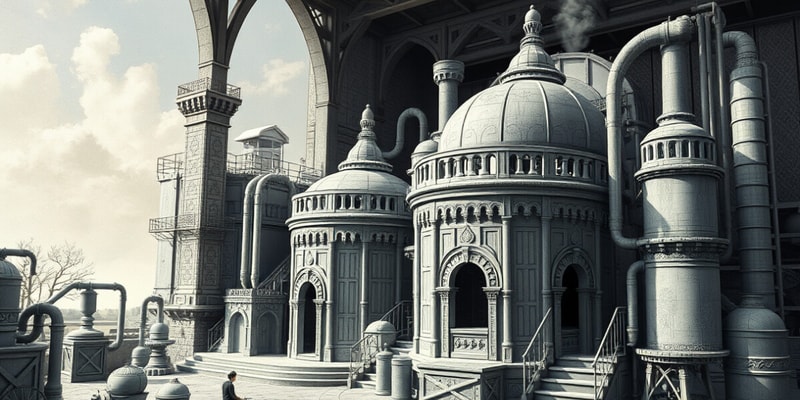Podcast
Questions and Answers
Cement is a building material that hardens over time when mixed with water.
Cement is a building material that hardens over time when mixed with water.
True
Blended cement is made solely from Portland cement without any additional materials.
Blended cement is made solely from Portland cement without any additional materials.
False
High-alumina cement is specifically resistant to high temperatures.
High-alumina cement is specifically resistant to high temperatures.
True
The manufacturing process of cement includes a step called clinking.
The manufacturing process of cement includes a step called clinking.
Signup and view all the answers
Cement is highly durable and resistant to weathering and chemical attacks.
Cement is highly durable and resistant to weathering and chemical attacks.
Signup and view all the answers
Portland cement is the least commonly used type of cement.
Portland cement is the least commonly used type of cement.
Signup and view all the answers
Cement production contributes significantly to CO2 emissions.
Cement production contributes significantly to CO2 emissions.
Signup and view all the answers
Cement should be stored in a moist environment to maintain its effectiveness.
Cement should be stored in a moist environment to maintain its effectiveness.
Signup and view all the answers
Sulphate-resisting cement is suitable for areas with high sulphate levels.
Sulphate-resisting cement is suitable for areas with high sulphate levels.
Signup and view all the answers
Cement is only used for making concrete.
Cement is only used for making concrete.
Signup and view all the answers
Study Notes
Definition
- Cement is a building material made from a mixture of minerals that, when mixed with water, forms a paste that hardens over time.
Types of Cement
-
Portland Cement
- Most common type.
- Made from limestone and clay.
- Used in concrete, mortar, and stucco.
-
Blended Cement
- Combines Portland cement with other materials like fly ash or slag.
- Improves workability and reduces environmental impact.
-
Specialty Cements
- Rapid-setting cement: Hardens quickly for fast repairs.
- High-alumina cement: Resistant to high temperatures.
- Sulphate-resisting cement: Used in environments with high sulphate levels.
Manufacturing Process
-
Raw Material Extraction
- Limestone and clay are mined.
-
Crushing and Grinding
- Materials are crushed and ground into a fine powder.
-
Clinkering
- Powder is heated in a kiln to 1400-1600°C to form clinker.
-
Cooling and Grinding
- Clinker is cooled and ground with gypsum to produce cement.
Properties
- Hydraulic: Sets and hardens when mixed with water.
- Strength: Develops compressive strength over time.
- Durability: Resistant to weathering, chemical attack, and wear.
Uses
- Used in construction for:
- Concrete production
- Mortar for masonry
- Flooring and paving
- Prefabricated structures
Environmental Impact
- Cement production is a significant source of CO2 emissions.
- Efforts are underway to develop more sustainable practices and alternative materials.
Storage and Handling
- Should be stored in a dry, airtight environment to prevent moisture absorption.
- Must be handled with care to avoid dust inhalation and skin contact.
Definition of Cement
- Cement is a building material composed of a mineral mixture that hardens into a solid when combined with water.
Types of Cement
-
Portland Cement:
- Predominantly used type, created from limestone and clay.
- Essential for producing concrete, mortar, and stucco.
-
Blended Cement:
- Mixes Portland cement with alternative materials like fly ash or slag.
- Enhances workability and lowers environmental impact.
-
Specialty Cements:
- Rapid-setting cement: Ideal for quick repairs as it hardens rapidly.
- High-alumina cement: Suitable for applications in high-temperature conditions.
- Sulphate-resisting cement: Designed for environments exposed to high sulphate levels.
Manufacturing Process
- Raw Material Extraction: Limestone and clay are sourced through mining.
- Crushing and Grinding: Mined materials are crushed and finely ground into powder.
- Clinkering: The powdered mixture is heated in a kiln at temperatures of 1400-1600°C to form clinker.
- Cooling and Grinding: Post-heating, the clinker is cooled and then ground with gypsum to produce finished cement.
Properties of Cement
- Hydraulic: Capable of setting and hardening when in contact with water.
- Strength: Builds compressive strength progressively over time.
- Durability: Resistant to various environmental impacts including weather, chemicals, and physical wear.
Uses of Cement
- Integral in various construction applications such as:
- Manufacturing concrete for structures.
- Creating mortar for masonry work.
- Implementing flooring and paving solutions.
- Producing prefabricated building components.
Environmental Impact
- Cement production significantly contributes to CO2 emissions.
- Ongoing initiatives focus on sustainable practices and alternative materials to mitigate environmental harm.
Storage and Handling
- Cement should be securely stored in a dry, airtight space to avoid moisture.
- Proper handling is crucial to prevent dust inhalation and skin irritation.
Studying That Suits You
Use AI to generate personalized quizzes and flashcards to suit your learning preferences.
Description
Explore the various types of cement including Portland, blended, and specialty cements. This quiz also delves into the manufacturing process of cement, covering raw material extraction, clinkering, and more. Test your knowledge on this essential building material.




